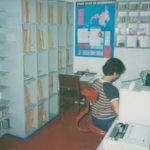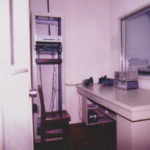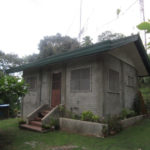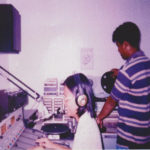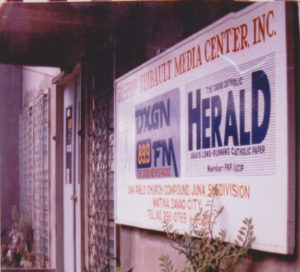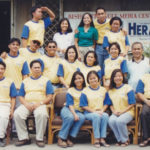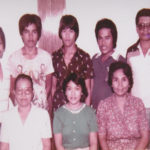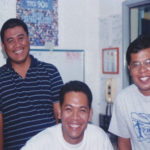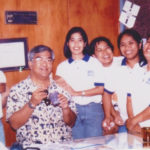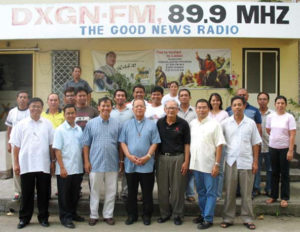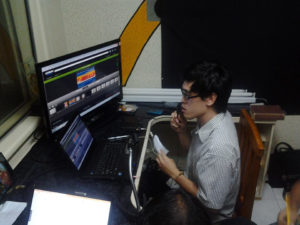It was during Fr. Rogelio Antalan’s directorship in 1968 when the plan to open a Catholic radio station was thought of. In fact, he was sent to Manila to study broadcasting. Afterwards, BTMC radio was materialized under his supervision along with the Daughters of St. Paul.
1980s
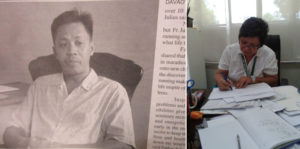
Msgr. Rodulfa is the current president of Holy Cross of Davao College, Inc., while Ms. Cecille Estardo is an officer of the Department of Agrarian Reform (DAR).
Yet the BTMC radio was confined only to recording songs and radio plays. Thus in 1985, the late Abp. Antonio Ll. Mabutas invited newscaster and ADDU mass communication professor Ms. Cecile Estardo to make a radio feasibility study. When completed, it was presented to the clergy and was sent to Germany’s “Misereor” for funding. Misereor is Catholic Bishop’s Organization for Development Cooperation.
Helped by Msgr. Rodulfa who was then the Archdiocesan procurator, the funding was used as a start-up capital. Ms. Estardo and Fr. Rodulfa facilitated the purchase of the 4, 000 sq. m. lot for the transmitter in Shrine Hills, Matina, sets of equipment, and albums for playing.
May 15, 1988, World Communications Day. Lay empowerment such as the organization of Charismatic movements flourished in the Archdiocese in this decade.
A lay, Ms. Estardo was appointed first station manager. Pioneering batch of staff were Lito Gualberto (Sales and Marketing), Lito Adana, Roger Lagrada, Oliver Durado (technicians), Jing Fernandez (librarian), Joey Dichoson, Alex Aquino, Raul “Bong” Roxas (Buddy Roy), Noel Amoroso, and Wilson Entrata.
Under her care, the station followed mixed programming (half religious, half commercial) where Filipino values were strongly emphasized through gospel-based and commercial songs. The station was composed of a DJs booth, technical booth, recording studio, and a library. She was succeeded by Fr. Aris Pesquera then Fr. Roger Duhaylungsod.
Later on, the archdiocese subsidized the operations of the radio for some time before it was closed down due to lack in financial backing before 90s came. The Notre Dame Broadcasting Corporation (NDBC) then rented the station. It played OPM hits thus, using the tagline “DXGN: Pinoy Radio!” It was loved by the masses thus, it ranked #1 on radio surveys. However, fierce media competition, breakdown of radio equipment, and cost of operation became deciding factors for its closure.
- Library
- Technician’s booth
- 4,000 sq. m. lot for DXGN transmitter at the Shrine Hills, Matina.
- DJs booth
1990s
After the installation of the 3rd archbishop of Davao Archbishop Fernando R. Capalla, DXGN was retrieved from NDBC in 1996. He instructed former volunteer, Mr. Noel Pinili to reopen and run the station with Mr. Celestino “Al” Baretto as finance in-charge.
Mr. Barretto and Mr. Ding Diaz donated P 100, 000 to help out its radio operations. The new administration tried “religious programming” where the whole-day format of 18 hours mirrored “Christian Life” through songs, prayers, and news. Support of “rich Catholics” through its “Mission Prayer Partners” project sustained the operations. Succeeded by Mr. Reuben Baldoza, Jr., Mr. Pinili turned over the same format in 1997.
With the newest BTMC director, Msgr. Guillermo V. Afable (now the bishop of Digos), DXGN remained to be the “Good News“ radio of the Archdiocese of Davao bringing a fresher tagline: “Making a Big Difference in Radio Broadcast Programming.”
To stabilize each media platform, DXGN and DC Herald newspaper separated their operations.
Former DC Herald’s EIC Mr. Florante Tarona went back and managed DXGN FM. As Holy Cross of Davao College Mass Communication’s coordinator, he intensified the involvement especially to the internship program of mass comm. students making the station extended laboratory of the school’s AB-Mass Communication program.
Fr. Dexter Veloso succeeded Mr. Tarona.
- Some of DC Herald and DXGN 89.9 staff during Bp. Afable’s administration.
- Former DC Herald’s EIC Mr. Florante Tarona (extreme left) went back and managed DXGN FM. As Holy Cross of Davao College Mass Communication’s coordinator, he intensified the involvement especially to the internship program of mass comm. students making the station extended laboratory of the school’s AB-Mass Communication program.
- DXGN technicians and station manager, Fr. Veloso.
- From right: Aileen Coquilla-Parilla (bookkeeper), Bp. Guillermo Afable (BTMC Director), Lalai Montajes (DJ), Ces Besario (DC Herald EIC), Melba Gabuya (DJ), Revelyn Macasa-Nengasca (News editor).
- DJs Darlene Antoniano, Cheryl Vilog, Lalai Montajes with an avid listener from the Sibulan Alliance Church, Lilia Camansa (center, standing).
2000s
The youth participated in the programming. Organized and anchored by HCDC employees Cheryl Vilog and Dahlia Ando-Reoma, Chikahan ng Barkada “Chikada” became the longest-running youth show aired in 6 years since 2001. Production staff included HCDC students and other San Pablo parish volunteers. It was adopted by the Davao Archdiocesan Youth Coordinating Apostolate (DAYCA) as its official youth radio program.
DXGN’s radio transmitter experienced major breakdown, though it had minor breakdowns during the management of NDBC where they started broadcasting up in the transmitter area. They had started tinkering with the direction of the transmitter and studio link transmitter to focus its power towards NDBC stations in Kidapawan as they are a network.
With the combined management under Fr. Rey Roque, the BTMC was renamed Archbishop Mabutas Media Center (AMMC) forming strong alliances for marketing with the Catholic Media Network (CMN) and NDBC again.
The new name of the foundation was in honor of the late archbishop Mabutas. DXGN 89.9 FM was re-launched as a medium of peace-building as the station bought hardware supplies at Broadcast Works (BW). It formed its station’s four-men marketing arm.
A research on the “Effects of Radio as Medium of Evangelization in the Archdiocese of Davao” confirms
that DXGN listeners tune in to radio because they were led to love God more dearly. The programs like Pulong sa Diyos, Kusog sa Katawhan, gospel-based songs, and Holy Mass coverage made them socially-aware and humane.
The CBCP’s Social communication Commission is more active during this time. They wanted to push for the networking of the different Catholic-run stations. This is the reason for the refocusing of programming of DXGN 89.9 to XGN-Generation’s Best. It was more of a market-driven move on the part of CMN to capture a bigger part of advertising revenues.
After Fr. Roque’s management, Abp. Capalla led the changing of the foundation’s name to Davao Verbum Dei Media Foundation. Inc. It was registered to Securities and Exchange Commission (SEC). Similar to other corporations, Davao Verbum Dei is subjected to audit from time to time, inspection, and examination of corporate and accounting books, records, names of beneficiaries, and agreements.
Deteriorating equipment and facilities, possibility of a new broadcasting technology without transmitter, the need to improve programming, marketing, personnel capability and effective community support, and dissolution of BMTC Foundation Inc. by SEC. prompted the BOT to shut down DXGN’s operation the third time. Nine (9) employees were paid what is due them (DXGN fm undergoes restructuring, 2008).
2011-0nwards
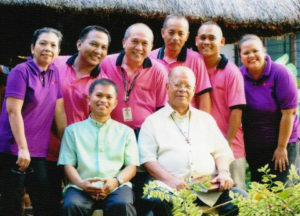
Fr. Ritsche J. Gamaya was appointed DC Herald’s managing editor and DXGN station manager. Anna (Layout artist), John Frances Fuentes (Reporter), Felix Tabuclin (Sales and Marketing), Julito Puliran (Circulation Head), Jay Montederamos (Driver/Utility), and Mae Renegado (Secretary/Cashier).
Fr. Ritsche J. Gamaya was appointed DC Herald’s managing editor and DXGN station manager. Anna (Layout artist), John Frances Fuentes (Reporter), Felix Tabuclin (Sales and Marketing), Julito Puliran (Circulation Head), Jay Montederamos (Driver/Utility), and Mae Renegado (Secretary/Cashier).
Technical consultant and former DXGN DJ/marketing executive, Cheryl Vilog (extreme right) made a comeback. While finishing her dissertation about pastoral planning for the media apostolate, she started writing again for a new column, “e-Cheng interactive” (later evolved to “Herald of the Good News” and “Kwento ng Ordinaryong Tao”), proofreading articles, and handling of the newest department, Research and Database. Offshoots of the pastoral plan included Vision-Mission and Goals, volunteers and internship programs concept papers, training and support modules (Media Baby ka ba? Church Media Caravan), and DXGN’s reopening feasibility. Taken at the courtesy call with Abp. Valles after his installation last May 22, 2012.
Before he retired as the Davao Verbum BOT Chair in 2012, Abp. Nanding Capalla offered to donate the proceeds of his b-day fund raising (Life Run) for the reopening of the Catholic radio station, DXGN 89.9 FM. With the start-up capital, the Foundation pushed on up to the reopening in December 2015.
Employees and volunteers crafted financial policies and worked on major areas for development such as inventory, archiving of DC Herald issues, reviewing job descriptions, and audience profiling.
The BOT members launched the Foundation’s official website www.davaocatholicherald.com. The Social Media department volunteers Argyll Villegas, Perry Lamanilao, Julius Piala, Jecy Opada, Julienne Mumar took the initiatives in opening and maintaining other online accounts such as DC Herald FB page, YouTube, and Twitter. Online TV and radio were also tested for live streaming capability.
Parish Social Communications (writers, sellers) were organized to assist the Foundation’s goal to reach the people in the GKKs.
The 2014 revised GKK Norms and Guidelines include in the structure the appointment of GKK Social Communications Committee (GKK SoCCom) to assist the programs of the Verbum Dei.
After series of media surveys, radio consultations, marketing meetings, crafting of programs, presentations to clergy and lay, fund-raising campaigns, DXGN’s test broadcast happened in December 2015. The National Telecommunications Commission and Catholic Media Network assisted in keeping the license and processing the radio papers.
In its 4th reopening, the management hopes that its operation be sustained through moral and financial support of all Catholics here and abroad.
ALL RIGHTS RESERVED.
DAVAO VERBUM DEI MEDIA FOUNDATION, INC. RESEARCH AND DATABASE DEPARTMENT
November 2011 – March 23, 2016

